Homefront Review (Campaign, 360)
- Updated: 18th Mar, 2011
This review focuses on the single-player campaign. Also see our Homefront Multiplayer Review.
 I launched into Homefront with very little preamble and not having known much about the game from the outset. My initial expectation was for something along the lines of Call of Duty: Modern Warfare 2’s “Invasion America” sequence, and although the end result is not far off the mark, it seems more akin to a re-envisioning of the classic 80s flick, Red Dawn. I found the game a competent if fairly standard shooter, which sadly, barely succeeds in differentiating itself from others in the genre.
I launched into Homefront with very little preamble and not having known much about the game from the outset. My initial expectation was for something along the lines of Call of Duty: Modern Warfare 2’s “Invasion America” sequence, and although the end result is not far off the mark, it seems more akin to a re-envisioning of the classic 80s flick, Red Dawn. I found the game a competent if fairly standard shooter, which sadly, barely succeeds in differentiating itself from others in the genre.
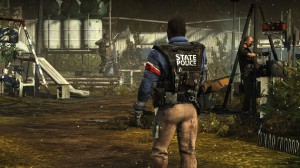 The premise is quickly summed up in the game’s flash-cut edited intro sequence: Kim Jong-Un has succeeded his father, unified Korea and due to a variety of economic and other political pressures, has taken over and utterly subsumed a weakened USA. Please pardon me while I wax poetic for a moment about the intro, given that it’s setting up the backstory for why the player is meant to be repeatedly shooting Korean dudes in the face… Perhaps it’s just me, but even with FMV inter-cut between infographics describing the situation, it’s still a lot less coherent and effective than the similarly-produced intro for Operation Flashpoint: Dragon Rising. I suspect that the details of how all this come about are present in the sole “collectible” element of the game, scraps of paper you may find scattered about the game’s various battlefields, but I found them largely boring and tedious to read during the heat of battle.
The premise is quickly summed up in the game’s flash-cut edited intro sequence: Kim Jong-Un has succeeded his father, unified Korea and due to a variety of economic and other political pressures, has taken over and utterly subsumed a weakened USA. Please pardon me while I wax poetic for a moment about the intro, given that it’s setting up the backstory for why the player is meant to be repeatedly shooting Korean dudes in the face… Perhaps it’s just me, but even with FMV inter-cut between infographics describing the situation, it’s still a lot less coherent and effective than the similarly-produced intro for Operation Flashpoint: Dragon Rising. I suspect that the details of how all this come about are present in the sole “collectible” element of the game, scraps of paper you may find scattered about the game’s various battlefields, but I found them largely boring and tedious to read during the heat of battle.
Once the game actually begins, the player is soon treated to scenes of “just how bad things have gotten” via an on-rails bus sequence, which I took to be an homage to the opening sequence for Half-Life. The story, we are told, is that the big, bad Korean empire is crushing the soul of America beneath its uncaring jackboot. Another of your fellow detainees on the bus whispers that they’re “rounding up pilots” for some unknown reason and we are treated to scenes that are reminiscent of the Alfonso Cuarón adaptation of Children of Men. Families are split apart, people are being rounded up in fenced camps and squalor is everywhere.
In short, the town of Montrose, Colorado and by extrapolation America at large, is fucked. I would be remiss for not mentioning one scripted sequence, a depiction of the execution of both parents in front of their child’s eyes. Even though the “uncanny valley” does little to import the gravity of that deplorable act, and perhaps it’s simply because I am myself a father, but I found the child’s cries particularly realistic and haunting. In essence, the game is painting a picture of the occupation of America, and it is not a kind one.
What a perfect situation to set you up with a gun, some ammunition, and no bubble gum whatsoever to chew! You are quickly aligned with “the resistance,” a John Connor-style cohort of rag tag guerilla fighters opposing the Korean People’s Army. One of the lieutenants is even named Connor. Your foe, the KPA, are pretty much a bunch of faceless evil baddies and on the whole, they are demonised so you don’t feel so bad about mowing them down like a horde of Nazi zombies.
As for the actual gameplay, and please be advised that I’ve primarily played FPS games on the PC, I found it to be fairly standard fare. The controls are likely familiar to everyone who’ve played FPS games in the past, with the left trigger aiming down the sights, and some weapons allowing for some snap-to autoaiming, which sufficiently made up for my comparative lack of skill with twin thumbsticks. Despite being set 16 years hence, the weapons are pretty much akin to any of our contemporary firearms, with the usual variety (or perhaps lack thereof) classed into pistols, assault rifles, shotguns, sniper rifles, etc. In general there isn’t much deviation from the formula.
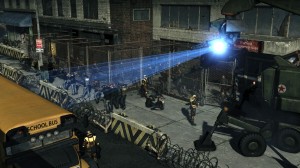 The one new element, if you can call it that, is the addition of Goliath, a robotic six-wheeled vehicle with an automated turret-mounted minigun and rocket launcher. At specific points in the game, the player is given limited control over Goliath, whereby you can bring up a targeting device which allows you to direct its wrath upon vehicles or enemies which stray into view. Unfortunately it feels less than novel at times because the enemy can easily counter with EMP ordnance which effectively neutralises Goliath for a few moments. Goliath is not always indestructible either, so in one way it’s sort of like turning the VIP game mechanic on its head; instead of just having to escort a defenseless vehicle, said vehicle can blow the shit out of things and knock down barricades that let you advance through the levels.
The one new element, if you can call it that, is the addition of Goliath, a robotic six-wheeled vehicle with an automated turret-mounted minigun and rocket launcher. At specific points in the game, the player is given limited control over Goliath, whereby you can bring up a targeting device which allows you to direct its wrath upon vehicles or enemies which stray into view. Unfortunately it feels less than novel at times because the enemy can easily counter with EMP ordnance which effectively neutralises Goliath for a few moments. Goliath is not always indestructible either, so in one way it’s sort of like turning the VIP game mechanic on its head; instead of just having to escort a defenseless vehicle, said vehicle can blow the shit out of things and knock down barricades that let you advance through the levels.
Speaking of the levels, I found them extremely linear and confining. Both visible and not-so-visible walls are everywhere in suburban America and the only thing differentiating them from other shooters of their ilk is the fact that they’re walls of trash and destroyed cars. Speaking of invisible walls, most often than not your own allies are such walls, and even though at various points I had ample opportunity to forge ahead, my companions would invisibly keep me back, or I was prevented from moving on to the next “zone” because I had to wait for a door to be broken down or a passage preceded by one of my fellows. Nearly all games have to make concessions like these, however, so it’s a minor point, but I suppose what’s notable about it is that it was noticeable at all. This is not an open world, but a very directed and controlled experience.
You move from set-piece to set-piece in a fairly predictable but not wholly dis-pleasurable fashion through to the ending, which took me about five or six hours at most. There are a few interesting moments that sufficiently mix things up but despite all of the set up, I didn’t find myself too terribly invested in what was going on. For example, you eventually discover the necessity for your character’s skills as a pilot and the game breaks up the monotony with a flying sequence: you’re to escort tankers of petrol, but it’s not quite clear exactly why it’s key or to whom you are delivering them.
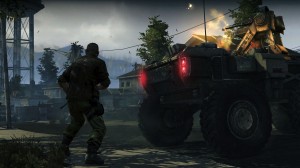 As you might have guessed, story-wise there isn’t much to write home about in Homefront. While not every game has to have a deep story to be enjoyable, Homefront seems to be trying to be something more serious than the over the top sensibilities of a game like Call of Duty: Modern Warfare 2. It’s a shame they didn’t have the time or context to make it a bit more nuanced. You play a faceless, nearly nameless hero. I only know my character’s surname was Jacobs because the other characters kept yelling at me to do things for them.
As you might have guessed, story-wise there isn’t much to write home about in Homefront. While not every game has to have a deep story to be enjoyable, Homefront seems to be trying to be something more serious than the over the top sensibilities of a game like Call of Duty: Modern Warfare 2. It’s a shame they didn’t have the time or context to make it a bit more nuanced. You play a faceless, nearly nameless hero. I only know my character’s surname was Jacobs because the other characters kept yelling at me to do things for them.
The game also makes an attempt at showing that the various forces pitted against the Koreans are not all white hats and sunshine, either. Unfortunately, these attempts at generating sympathy for the invading force as just being “people following orders” are crude at best, and are perpetrated by people with a specific variety of Southern American accent… I don’t mean to go overboard on political correctness, but it seemed obvious to me that they were just demonising a slightly different kind of enemy in those sections, rather than making a severe commentary about the horrors of war. Your sole female compatriot, Rianna, makes allusions to “not signing up for this” when you inevitably trade shots with said enemy, but the sentiment isn’t really heard or felt in the context of the situation.
On the other hand, your de facto leader, Connor, is himself portrayed as someone fairly unsettled by years of famine and conflict, and – despite the thin opportunities for characterisation in the increasingly Michael Bay-esque set pieces – I did enjoy the idea that he was probably not a nice person, even before he took up the mantle of resistance fighter.
Speaking of adding dimensions to the characters, I’m surprised that they hadn’t orchestrated it so that a few small pockets of KPA troops were rebelling or going against orders, given that an entire half of Korea had in theory previously held an entirely different idealogy.
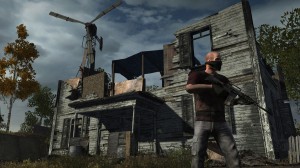 Your AI companions are competent enough and you don’t always notice them for the immortal entities they are. If you are slow to take out your enemies, you will find them dispatched given enough time. Apart from the invisible walls your companions present at specific points, they rarely get in your way and are seemingly incapable of shooting you inadvertently or dying due to your own friendly fire. I should say I found the challenge to be moderate, although others more experienced with console shooters will probably find it somewhat easy. It borrows the familiar mechanic of hiding in cover when wounded, and thankfully I found myself very infrequently frustrated by the game’s difficulty. There are no cardinal sins committed where checkpoints and reloading are concerned and the game flowed pretty smoothly to conclusion.
Your AI companions are competent enough and you don’t always notice them for the immortal entities they are. If you are slow to take out your enemies, you will find them dispatched given enough time. Apart from the invisible walls your companions present at specific points, they rarely get in your way and are seemingly incapable of shooting you inadvertently or dying due to your own friendly fire. I should say I found the challenge to be moderate, although others more experienced with console shooters will probably find it somewhat easy. It borrows the familiar mechanic of hiding in cover when wounded, and thankfully I found myself very infrequently frustrated by the game’s difficulty. There are no cardinal sins committed where checkpoints and reloading are concerned and the game flowed pretty smoothly to conclusion.
The game looks like a variation of the Unreal engine, with all its niceties and flaws. Menus are fairly sparse and loading screens during the inevitable respawns. While they offer some background to the world of Homefront, they aren’t particularly inspired or insightful. There are no difficulty settings or other thrills in the options menu. I suspect Kaos Studios wanted to go for something approachable and straightforward.
For me, the real immersion in a game happens with the attention to smaller details, which can’t always be boiled down to straight up graphical splendour. Personally, I would have expected that most of your fellow Americans would be gaunt, and perhaps even sickly given the hateful regime and economic collapse they have lived under for 10+ years. Rianna and the rest of your troops may not have the proportions of Christian Bale from the Machinist, but thoughtfully they’re not exactly Dom from Gears of War, either. There are a couple of throwaway segments that go a long way to explain the context, however. When a child comes begging for food and Connor dismissively waves him away but it’s a shame there aren’t more opportunities for grounding you in the “post oil” world that Homefront tries to immerse you in.
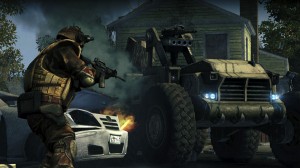 By the conclusion, you are fighting alongside the remnants of the US Army in the requisite set-piece battle to control a recognisable landmark in San Francisco. Perhaps I missed it during the brief recaps, narrated by the “voice of freedom” broadcasts that play during initial level loads, but I wasn’t sure why I was there or what we were trying to accomplish, beyond pushing the enemy back.
By the conclusion, you are fighting alongside the remnants of the US Army in the requisite set-piece battle to control a recognisable landmark in San Francisco. Perhaps I missed it during the brief recaps, narrated by the “voice of freedom” broadcasts that play during initial level loads, but I wasn’t sure why I was there or what we were trying to accomplish, beyond pushing the enemy back.
And to that point, I should say that Homefront seems to be trying to make some effort to say that the horrors of war are ultimately the greatest evil, but at the same time, they’re also trying to make a commercially viable shoot-’em-up game, so the message is muted. This is a shame because I didn’t find it thought-provoking, as I think it could have been. While a commercial FPS is probably not the proper forum for sparking debates about peak oil, economic collapse or totalitarian occupation; for the simple sake of advancing games as a mature medium, it’s a bit of a missed opportunity.
In summary, I think Homefront is a competent shooter and can be an enjoyable experience depending on one’s expectations, but at the end of the day it does what it says on the tin. That probably sums it up best in fact; it’s a straightforward shooter with an intriguing premise but perhaps won’t win any awards down the line.
More interested in the PvP side of shooters? Read our HomeFront Multiplayer review.
Homefront is available now on Windows, Xbox 360 and PlayStation 3


Follow Us!